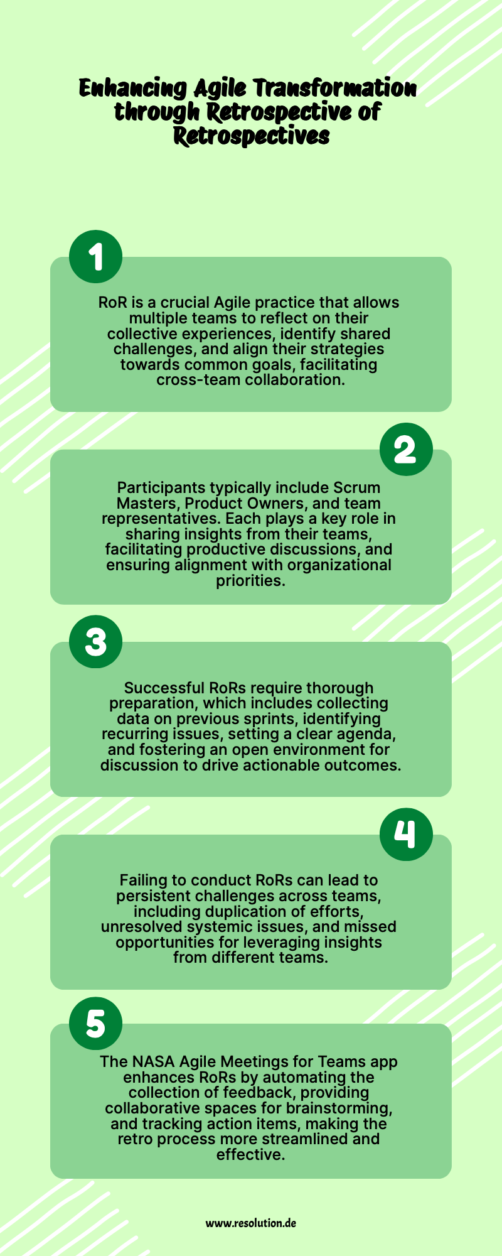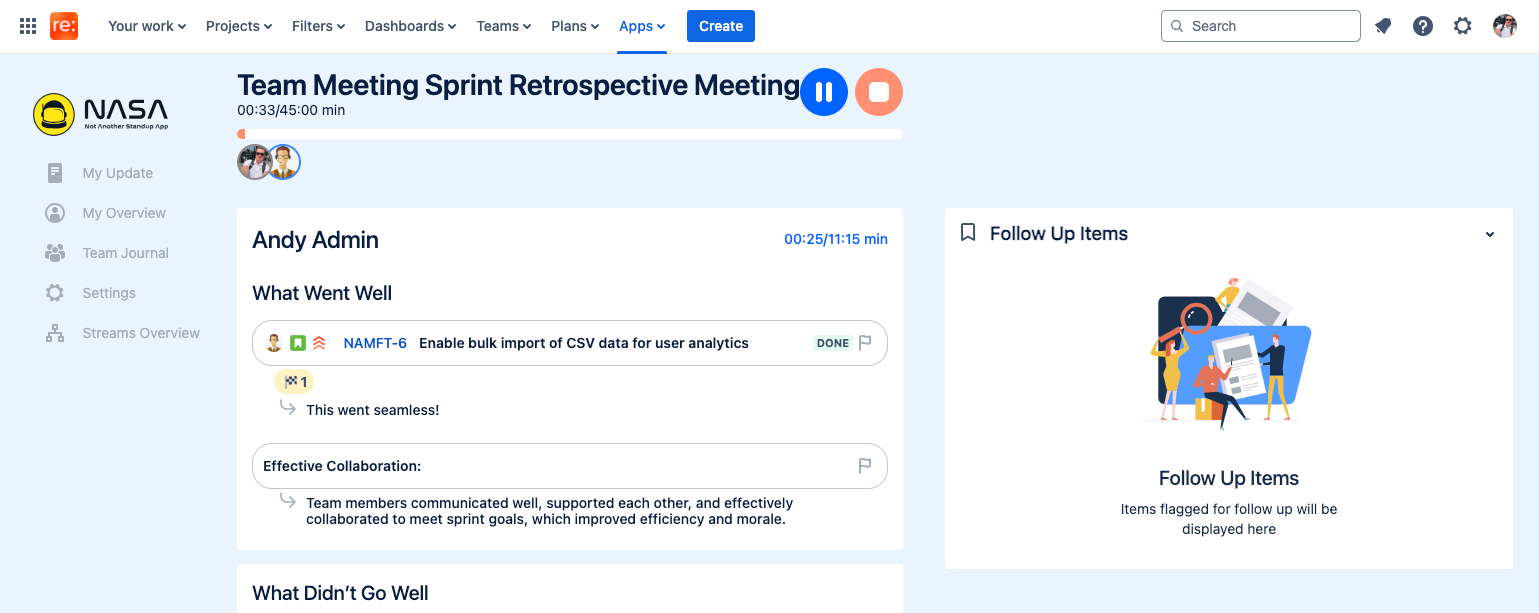In the dynamic world of Agile Retrospectives play a pivotal role in driving continuous improvement. But when organizations scale, involving multiple scrum teams working on interconnected projects, a single team’s retrospective isn’t enough. Enter the Retrospective of Retrospectives (RoR)—a vital ceremony that brings together key representatives from multiple scrum teams to identify common challenges, share insights, and align strategies.
RoRs are indispensable for Agile organizations aiming to foster collaboration and achieve broader organizational goals. They allow agile teams to step back and reflect on patterns across multiple sprints or projects, uncovering systemic issues that may be holding them back. When executed effectively, these meetings serve as a cornerstone for alignment, trust-building, and continuous improvement.
In this post, we’ll explore the best practices for mastering Retrospective of Retrospectives and spotlight how the NASA Agile Meetings for Teams app simplifies and enhances the process, setting you up for success.
Key Takeaways
By the end of this article, you’ll understand:
The significance of Retrospective of Retrospectives in scaled Agile frameworks.
Key participants and their roles in ensuring meeting success.
Practical tips for preparing and conducting impactful RoRs.
How the NASA Agile Meetings for Teams app streamlines data collection, collaboration, and follow-through.
Understanding Retrospective of Retrospectives Meetings
At its core, the Agile Retrospective of Retrospectives is an Agile practice designed to extend the benefits of individual scrum team retrospectives to a multi-team level. It addresses overarching questions like:
What recurring challenges are affecting multiple teams?
How can teams collaborate more effectively?
What systemic changes could improve delivery and morale across the organization?
The Collaborative Process
The Retrospective of Retrospectives typically involves Scrum Masters, Product Owners, and selected agile team representatives. Each participant brings insights from their respective teams to the table, fostering cross-functional dialogue. The goal is to collectively identify patterns, brainstorm solutions, and align on actionable next steps.
Importance of Agile Retrospective of Retrospectives
Why Retrospective of Retrospectives Matter
Retrospective of Retrospectives help Agile organizations:
Align Cross-Team Efforts: Without them, teams may inadvertently work at cross-purposes or duplicate efforts.
Address Systemic Challenges: Issues like dependency bottlenecks, communication breakdowns, or mismatched priorities can remain unresolved without a holistic view.
Promote Shared Accountability: RoRs encourage entire teams to work together toward shared goals rather than focusing solely on their individual objectives.
What Can Go Wrong Without Retrospective of Retrospectives?
Without proper cross-team retrospectives, organizations may face:
Recurring Issues: Teams repeatedly struggle with the same blockers.
Siloed Teams: Lack of alignment leads to inefficiencies and frustration.
Lost Opportunities: Insights from one team may never benefit others.
For example, consider a distributed team struggling with asynchronous communication. Without an RoR, their challenges may never reach leadership or inspire solutions that could benefit the organization as a whole.
Key Objectives of an Agile Retrospective of Retrospectives Meeting
A successful Retrospective of Retrospectives focuses on:
Identifying Common Challenges: Recognizing recurring themes across teams.
Sharing Best Practices: Highlighting approaches that have worked well for one team and could be replicated elsewhere.
Fostering Collaboration: Building trust and rapport between teams to tackle challenges collectively.
Driving Actionable Outcomes: Ensuring every meeting concludes with clear next steps.
These objectives ensure that Retrospective of Retrospectives are not just reflective but transformative, directly influencing organizational success.

Who Should Attend a Retrospective of Retrospectives Meeting?
Key Participants
Scrum Masters: Facilitate the meeting and provide insights into team dynamics.
Product Owners: Represent business priorities and ensure alignment with strategic goals.
Team Representatives: Share specific challenges, wins, and insights from their entire teams.
Importance of Collaboration
The strength of an Retrospective of Retrospectives lies in its diversity. Each attendee brings unique perspectives, making it easier to identify systemic issues and craft well-rounded solutions.
Roles and Responsibilities
Each participant plays a crucial role in the success of an Retrospective of Retrospectives:
Scrum Masters: Ensure the discussion remains productive and focused.
Product Owners: Advocate for solutions that align with organizational priorities.
Team Representatives: Provide detailed context from individual teams and contribute to action item brainstorming.
Preparation Steps
Preparation is key to an effective Retrospective of Retrospectives. Here’s how to get started:
Collect Data: Review feedback and metrics from previous sprints.
Identify Recurring Issues: Look for patterns across team retrospectives.
Prepare Discussion Points: Highlight key themes to address.
Set the Agenda: Ensure the meeting has a clear structure and purpose.
How to Conduct an Effective Agile Retrospective of Retrospectives Meeting
Follow this step-by-step guide:
Set the Stage: Begin by establishing psychological safety to encourage open dialogue.
Review Data: Present aggregated insights from previous sprints.
Facilitate Discussions: Use techniques like brainstorming or fishbone diagrams to identify root causes.
Prioritize Issues: Focus on challenges that have the greatest impact on organizational goals.
Define Action Items: Ensure every issue is paired with a clear, actionable next step.
Summarize Outcomes: Conclude with a recap of decisions and responsibilities.
Tips for Success
Use visuals to keep discussions engaging and focused.
Limit the meeting to 90 minutes to maintain energy and focus.
Follow up regularly on action items to ensure accountability.
How NASA Agile Meetings for Teams Enhances Agile Retrospective of Retrospectives
The NASA Agile Meetings for Teams app is a game-changer for RoRs. Here’s how it supports your efforts:
Key Features
Data Aggregation: Automatically collates feedback and metrics from individual retrospectives.
Collaborative Boards: Provides a digital space for brainstorming and documenting outcomes.
Action Item Tracking: Tracks progress on follow-up items, ensuring nothing falls through the cracks.
Tool Integration: Seamlessly integrates with tools like JIRA, making it easier to align efforts across teams.
Real-World Impact
By streamlining preparation and follow-up, the app allows teams to focus on meaningful discussions and actions. Imagine transforming a chaotic RoR into a well-structured, results-driven meeting with just a few clicks.

Summary
Agile Retrospective of Retrospectives meetings are an essential practice for scaled Agile organizations, promoting alignment, collaboration, and continuous improvement. By following best practices and leveraging tools like the NASA Agile Meetings for Teams app, you can elevate these meetings from routine ceremonies to powerful catalysts for organizational success.
Ready to master your Retrospective of Retrospectives meetings?
Schedule a Demo: See the NASA Agile Meetings for Teams app in action.
Visit Our Product Page: Explore features tailored to Agile teams.
Download the App: Available now on the Atlassian Marketplace.
Empower your teams to drive meaningful improvements and achieve organizational excellence.
Frequently Asked Questions
What’s the difference between a Agile Retrospective and a Retrospective of Retrospectives?
While a Retrospective focuses on a single team’s performance, an RoR examines patterns across multiple teams to address broader challenges.
How often should RoRs be conducted?
RoRs are typically held at the end of each Program Increment or after every few sprints, depending on organizational needs.
How can I ensure action items from RoRs are implemented?
Tools like the NASA Agile Meetings for Teams app help track progress and maintain accountability for follow-up items.
What tools can enhance RoRs?
Collaborative tools like Miro, Confluence, and the NASA Agile Meetings for Teams app simplify data sharing and foster engagement.
By embracing these best practices and leveraging innovative tools, you can ensure your Retrospective of Retrospectives meetings deliver measurable results, aligning your teams for sustained success.
Mastering Agile Retrospectives: A Practical Guide for Continuous Improvement
What is an Agile Retrospective?
A retrospective is a meeting held at the end of a sprint or project to reflect on the process and gather feedback.
It’s a chance for teams to learn from past events, identify areas for improvement, and build an action plan for continuous improvement.
Agile retrospectives are a critical step in the Scrum masters’ process, helping teams improve and adapt to changes.
Benefits of Agile Retrospectives
Agile Retrospectives provide a focused time for teams to learn from the past and each other.
They improve productivity, team dynamics, and customer value.
Insights from retrospectives can be used to improve the development process.
Regular retrospectives help teams identify solutions to problems and acknowledge successes.
Agile Retrospective Best Practices
Set an expected duration and frequency for the agile retrospective meeting.
Come prepared with a framework and agenda.
Choose a facilitator to keep the discussion on track.
Keep the meeting collaborative, encouraging honesty and shared responsibility.
End the meeting with action items and make meeting notes accessible.
Preparing for a Retrospective
Prepare for agile retrospectives by setting a clear agenda and encouraging team members to add their thoughts prior to the meeting.
Use a retrospective template to guide the retro process and identify areas of improvement.
Ensure all team members can attend and participate.
Conducting Retrospectives
Gathering Feedback
Gather feedback from team members using techniques such as the 4 L’s, dot voting, or Lean coffee.
Encourage team members to share their perspectives on what went well and what didn’t during the project or iteration.
Use a retrospective board to guide the retro process and identify areas of improvement.
Generating Insights
Look for patterns and themes in the data that emerges from the team’s discussion.
Ask questions to clarify and explore any areas of ambiguity.
Identify strengths and areas for improvement.
Creating Action Items
Conduct a brainstorm on possible solutions or new ideas that can make the next sprint or project better based on the feedback from these retrospectives.
Group similar or duplicate items and hold a vote to assign a priority to the changes.
Leave the retrospective with specific action items to implement.
Agile Teams and Retrospectives
Agile teams hold retrospective meetings after a time-boxed period of work is complete.
The team discusses what went well, what didn’t go as planned, and how to make the next work period better.
Agile retrospectives help teams identify how to improve processes, prevent past mistakes, and anticipate future problems.
Common Retrospective Mistakes to Avoid
Skipping or delaying the retrospective meetings is a costly mistake.
Always asking the same questions can lead to boredom and disengagement.
Allowing some of the group to dominate the conversation can lead to limited insights.
Failing to empower softer voices can lead to undervalued contributions.
Implementing Insights from Retrospective Meetings
Implement insights into the next sprint or project.
Review action items from the previous retrospective meeting at the next meeting.
Determine progress and what still needs to be done.
Team Reflects: The Importance of Continuous Improvement
Encourage team members to capture lessons and thoughts during the sprint and focus on meaningful conversations during the retrospective meeting.
Team reflects on past events, learn from them, and build an action plan to drive rapid improvement.
Sprint Retrospectives Format
Use a retrospective format for each meeting, such as a retrospective board.
Create a retrospective board to help guide the retro process and identify areas of improvement.
Customize the template to suit your team’s needs.
Achieving Successful Retrospectives
Run retrospectives with a flexible agenda and maximize F2F meeting time.
Ensure everyone’s voice is heard and use strategies to include everyone.
Establish specific action items and review them at the next retrospective.
Conclusion
Retrospectives are a critical step in the Scrum process, helping teams improve and adapt to changes.
By following agile retrospectives’ best practices and avoiding common mistakes, teams can achieve successful retrospectives and drive continuous improvement.




